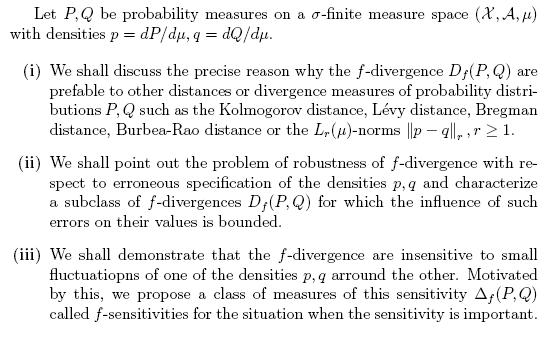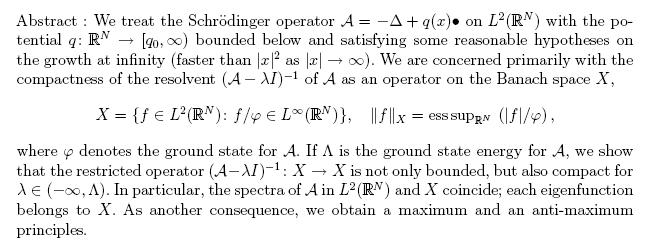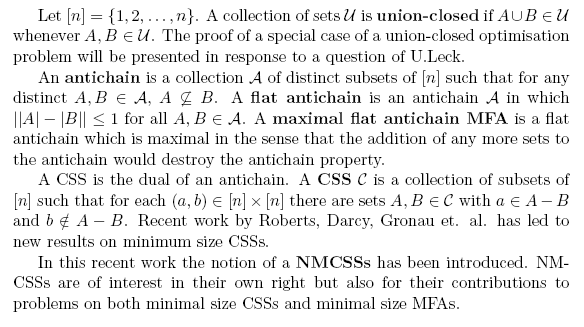Öffentliche Veranstaltungen
2007
Prof. Dr. Igor Vajda,
"Why f-divergences, robust f-divergences and f-fluctuations?"
Abstract:

17.12.07, 15.00 Uhr, kleiner HS Physik,
Institut für Physik, Universitätsplatz 3
Kolloquiumsleiter: Prof. F. Liese
Dr. Olaf Schröder,
Pattern Expert & NeuroProof GmbH
"Analyse der Aktionspotentialmuster von MEA-Neurochips"
Abstract:
Neuronale Netzwerke von Nervenzellkulturen auf
Mikroelektroden-Array Neurochips erzeugen komplexe Aktivitätsmuster.
Diese Aktivitätsmuster zeichnen sich durch ein Wechselspiel
von zufällig spontanem und
gesetzmäßig reproduzierbarem Verhalten aus.
Es werden Ergebnisse vorgestellt, wie solche Aktivitätsmuster
analysiert werden können.
Anschließend sollen Fragen der Modellierung und der Berechnung
charakteristischer Parameter für solche Netzwerke diskutiert werden.
22.11.2007, 17:00 Uhr, HS 120,
Universitätshauptgebäude, Universitätsplatz 1
Kolloquiumsleiter: PD Dr. R. Labahn
Prof. Dr. Benedicte Alziary,
Universite Toulouse 1
"The Ground State and Other Eigenfunctions for
the Schroedinger Operator with a Fast Growing
Potential"

15. November 2007, 15:00 Uhr, HS 120,
Universitätshauptgebäude, Universitätsplatz 1
Kolloquiumsleiter: Prof. Dr. Peter Takac
Dr. Nicholas Cavenagh,
University of New South Wales
"On completing three cyclic transversals to a latin square"
Abstract:
In this talk we consider the problem of completing a partial latin square,
where the partial latin square is of prime order p and consists of three
cyclically generated transversals. We examine the particular case when
two symbols in the first row of the partial latin square share a common
difference with their column.
18.07.2007 , 13.15 Uhr, Raum 31
Universitätshauptgebäude, Universitätsplatz 1
Kolloquiumsleiter: PD Dr. M. Grüttmüller
Dr. rer. nat. Cesar Poupaud,
Universite Toulouse 1
"Some spectral results for Schroedinger operators
on manifolds"
Abstract:
A natural question in spectral theory of self-adjoint operators is to find out
if the spectrum is discrete or not.
This problem is strongly related to the existence of the essential spectrum.
We present a localization result for the essential spectrum of Schrödinger
operators $-\Delta+V$ on Riemannian manifolds. In particular, this provides
some interesting criterions for the discreteness of the spectrum, or
equivalently, the compactness of the resolvent. We also show how such a result
can be used to prove the existence of the principal eigenvalue.
In the second part, we discuss a CLR-type estimate for the number of eigenvalues lying under the essential spectrum. This estimate is given in terms of an
integral quantity relating the potential and the heat kernel of the Laplacian on the manifold.
21.06.2007,15:00 Uhr (c.t.), HS 219,
Universitätshauptgebäude, Universitätsplatz 1
Kolloquiumsleiter: Prof. Peter Takac
Prof. Andrew Knyazev
"Majorization for Changes in Ritz Values and Canonical Angles Between
Subspaces"
Abstract:
We prove that the absolute value of the difference of the squares of the
cosines/sines of angles between subspaces is majorized by the sines of
the angles between the perturbed subspaces, with a constant of one. We
show that this result can be interpreted as a bound on the change of the
Ritz values in the Rayleigh-Ritz method with the change of the trial
subspace, in a particular case where the Rayleigh-Ritz method is applied
to an orthogonal projector. We then prove the general result for an
arbitrary Hermitian operator, not necessarily a projector, where the
constant becomes the difference between the largest and the smallest
eigenvalues of the operator. Our proof is based on an extension of an
arbitrary Hermitian operator to an orthogonal projector.
13.06.2007, 15 Uhr c.t., HS 219,
Universitätshauptgebäude, Universitätsplatz 1
Kolloquiumsleiter: Prof. Dr. K. Neymeyr
09.06.2007,
Institut für Physik, Universitätsplatz 3, ab 10.00 Uhr
Flyer (mit dem Programm)
Prof. Dr. Gabriele Steidl,
Universität Mannheim, Fachbereich Mathematik
"Anwendungen von Regularisierungen mit Ableitungen höherer
Ordnung in der Bildverarbeitung"
25.05.2007, 13.00 Uhr, HS 120,
Universitätshauptgebäude, Universitätsplatz 1
Kolloquiumsleiter:
Prof. Dr. M. Tasche
Dr. Stefan Kunis,
Technische Universität Chemnitz, Fakultät für Mathematik
"Effiziente Rekonstruktion von Funktionen auf der
Sphäre aus Funktionswerten"
23.05.2007, 15.15 Uhr, HS 219,
Universitätshauptgebäude, Universitätsplatz 1
Kolloquiumsleiter:
Prof. Dr. M. Tasche
Prof. Dr. Ivo Rosenberg,
Department de Mathematiques et Statistique,
Universite de Montreal, Canada
"Clones and relations; extensions
and recent developments"
Abstract:
We introduce operations and their composition, clones and for
finite universes their relational description and the corresponding
Galois connection. Next we dicuss completeness and maximal and
minimal clones. For infinite universes we discuss local clones and
local completeness.
Extensions: transformation monoids, permutation
groups, partial clones, hyperclones and multiclones, uniformly
delayed operations and clones and their completeness, composition of
automata.
23.05.2007, 13.15 - 14.15 Uhr, Raum 31,
Universitätshauptgebäude, Universitätsplatz 1
Kolloquiumsleiter:
Prof. Dr. D. Lau
Prof. Dr. Lucien Haddad,
Department de Mathematiques et d’Informatique,
College militaire royal du Canada, Kingston
"Colouring Projective Geometries"
18.05.2007, 14.30 - 15.15 Uhr, Raum 31,
Universitätshauptgebäude, Universitätsplatz 1
Kolloquiumsleiter:
Prof. Dr. D. Lau
Prof. Dr. Masahiro Miyakawa,
Tsukuba University of Technology, Dept. of Computer
Science, Japan
"Semirigid Equivalence Relations"
Abstract:
A system R of equivalence relations on a set A
(with at least 3 elements)
is semirigid if only the trivial operations (that is the projections
and constant functions) preserve all members of R.
- To a system R of equivalence relations we associate a graph
 .
We observe that if R is semirigid then the graph
.
We observe that if R is semirigid then the graph
 is 2-connected. We show that the converse holds if all the
members of R are atoms of the lattice E of equivalence relations
on A.
is 2-connected. We show that the converse holds if all the
members of R are atoms of the lattice E of equivalence relations
on A.
- We present a notion of graphical composition of semirigid systems and show that it preserves semirigidity.
- We show by a purely relational method that the joint-endomorphism of Zadori’s three equivalence relations on a set E is semirigid. Here we use a so called "Wheatstone bridge" which is a device to yield an equivalence relation θ=W(α,β,γ) from a triple α,β,γ of equivalence relations such that if a function f : A → A preserves α,β,γ jointly, then it preserves θ.
Kolloquiumsleiter: Prof. Dr. D. Lau
Prof. Steve Russ,
University of Warwick
"Modelling Informal Mathematics"
09.05.2007, 17.00 Uhr, HS 219, Universitätshauptgebäude,
Universitätsplatz 1
Kolloquiumsleiter:
Prof. Dr. K. Neymeyr
Dr. rer. nat. Tim Nesemann,
Vorstandsmitglied (Finanzen, Risiko und IT), Sparkasse Bremen AG
"Probleme des Einsatzes mathematischer Modelle in
Kreditinstituten"
Abstract:
In Kreditinstituten werden in jüngerer Zeit immer mehr mathematische
Modelle eingesetzt, insbesondere zur Steuerung von Risiken. In dem Vortrag soll
ein kurzer Überblick über die besonderen Risiken in Kreditinstituten
und die zu ihrer Steuerung eingesetzten Modelle gegeben werden. Im Anschluss
daran sollen verschiedene betriebswirtschaftliche, volkswirtschaftliche und
rechtliche Probleme dieser Entwicklung aufgezeigt werden, aus denen Anregungen
für die wissenschaftlichen Fragestellungen und die studentische Ausbildung
abgeleitet werden könnten.
Nach dem Vortrag wird Herr Dr. Nesemann gerne Ihre Fragen beantworten.
30.04.2007, 15.00 Uhr c.t., Hörsaal 3,
Parkstraße 6
Kolloquiumsleiter:
Prof. Dr. P. Takac
Priv.-Doz. Ph.D. Petr Girg,
Universität Pilsen
"Quasilinear Boundary Value Problems - combined theoretical,
numerical and symbolical approach"
26.04.2007, 15.00 Uhr, HS 219, Universitätshauptgebäude,
Universitätsplatz 1
Kolloquiumsleiter:
Prof. Dr. P. Takac
Im Rahmen des Fakultätskolloquiums hält
Herr Prof. Dr. Florian Pfender
seine Antrittsvorlesung zum Thema
"Obere Schranken für Codes durch lineare und semidefinite
Programmierung"
12.04.2007, 17.00 Uhr, Großer Hörsaal des Institutes
für Chemie (Albert-Einstein-Str. 3)
Prof. Dr. Adelinde Uhrmacher,
Institut für Informatik
"Überblick über James II - Ein komponentenbasiertes
Framework zur Modellierung und Simulation"
Abstract:
James II has been developed as a modeling and simulation framework that
allows to easily integrate new
functionality, e.g. modeling formalisms, simulators, partitioning
algorithms, or specialized user interfaces, and
combine those on-demand and even partly during run-time.
The benefits of this flexible design take effect in concrete
applications as well as in developing
new modeling and simulation methods. Being able to exchange modeling
formalisms, e.g. process algebra or
DEVS, might lead to an more effective modeling. The efficiency of
simulation runs can be increased
by combining different parallel and sequential simulators according to
the model and the available infrastructure.
In addition, due to the reuse of common parts and the ease of extensions
designing and evaluating new simulation
algorithms is facilitated.
31.01.2007, 13.15 - 14.45 Uhr, HS 219,
Universitätshauptgebäude, Universitätsplatz 1
Kolloquiumsleiter:
Prof. Dr. K. Engel
PD Dr. Ulrich Orbanz, Swiss Re München
"Die künftigen Herausforderungen für den Aktuar und
Konsequenzen für die Ausbildung"
Abstract:
Der Vortrag beginnt mit einer Beschreibung der Tätigkeitsfelder und der
typischen Aktivitäten von Aktuaren.
Anschließend wird an aktuellen Beispielen erläutert, welche
mathematischen Werkzeuge vom Aktuar benötigt werden und welche Kenntnisse
über die Mathematik hinaus für den Aktuar von Bedeutung sind.
Zum Abschluss wird die aktuelle Ausbildung zum Aktuar DAV vorgestellt und
die Rolle der Hochschulen an dieser Ausbildung erklärt.
[Folien]
17.01.2007, 18.30 Uhr, Kleiner Hörsaal Physik,
Universitätsplatz 3
Kolloquiumsleiter:
Prof. Dr. H. Milbrodt
Dipl.-Math. Marko Helwich,
Universität Rostock
"Semi-Markov Modelle in der Personenversicherung am Beispiel
Berufsunfähigkeits- und Privater Krankenversicherung"
17.01.2007, 15.00 Uhr, Kleiner Hörsaal Physik,
Universitätsplatz 3
Kolloquiumsleiter:
Prof. Dr. H. Milbrodt
Prof. Ian Roberts,
Charles Darwin Universität, Australien
"Some Recent Problems and Results on Finite Sets"
Abstract:
A number of different inter-related problems on finite sets will be outlined
including some new results and several open problems. The generic problem
in most cases is to find minimum size instances of a given mathematical
structure.
The following key ideas will be included: union-closed collections,
completely separating sytems (CSSs), the new concept of near-minimal CSSs
(NMCSSs), maximal flat antichains.

17.01.2007, 13.30 Uhr, Raum 31, Universitätshauptgebäude,
Universitätsplatz 1
Kolloquiumsleiter:
PD Dr. Martin Grüttmüller
Dr. habil. Dominik Hepperle,
SequentiX - Digital DNA Processing
"Die DNA-Sequenzierung: Methodik und Probleme"
Abstract:
Die Analyse von DNA-Sequenzdaten hat sich innerhalb der letzten 10 Jahre zu
einer Standardmethode in der biomedizinischen Forschung entwickelt. Sie
wird zur Identifikation von Organismen, zur Untersuchung von Krankheitsursachen
und -verlauf, zur Entwicklung von Pharmazeutika, in der Züchtungsforschung
und in vielen anderen Forschungsgebieten angewandt.
Im Rahmen des Vortrags wird die Methodik der DNA-Sequenzierung vorgestellt und
die nachgeschaltete Analyse der Rohdaten diskutiert. Hierbei sind vor allem
Algorithmen zur Signalverarbeitung (Peak-Identifikation) und
SuperString-Montage (Assembly) von Wichtigkeit.
03.01.2007, 13.30 Uhr, Raum 31,
Universitätshauptgebäude, Universitätsplatz 1
Kolloquiumsleiter:
PD Dr. R. Labahn
Prof. Dr. Silvelyn Zwanzig,
Uppsala University
"On comparison of simulation experiments"
Abstract:
Resampling and simulation methods like bootstrap or Simex are
based on new generated observations. The name simulation experiment
is introduced for the family of probability measures of these
simulated samples. The family of measures of the original sample
is called original experiment. Both types of experiments are defined
on different probability spaces - nevertheless the wanted parameter
is the same. In that situation the concept of Le Cam is applied for
comparing experiments by their deficiency and distance.
References:
[1] J.R. Cook and L.A. Stefanski; Simulation-extrapolation in parametric
measurement error models.1994 J. Amer. Statist. Assoc. 89, 1314-1328
[2] O. Hansen and E. Torgersen; Comparison of Linear Normal Experiments,
The Annals of Statistics, 1974, Vol. 2, No. 2, 367-373
[3] Le Cam; Asymptotic Methods in Statistical Decision Theory, Springer
1986
[4] Le Cam and Lo Yang; Asymptotics in Statistics. Springer 2000
[5] S. Zwanzig; On the Comparison of Simulation Experiments, U.U.D.M.
Report 2006-11,
http://www.math.uu.se/~zwanzig/papers/E1a.pdf
03.01.2007, 13.30 Uhr, HS 120,
Universitätshauptgebäude, Universitätsplatz 1
Kolloquiumsleiter:
Prof. Dr. F. Liese